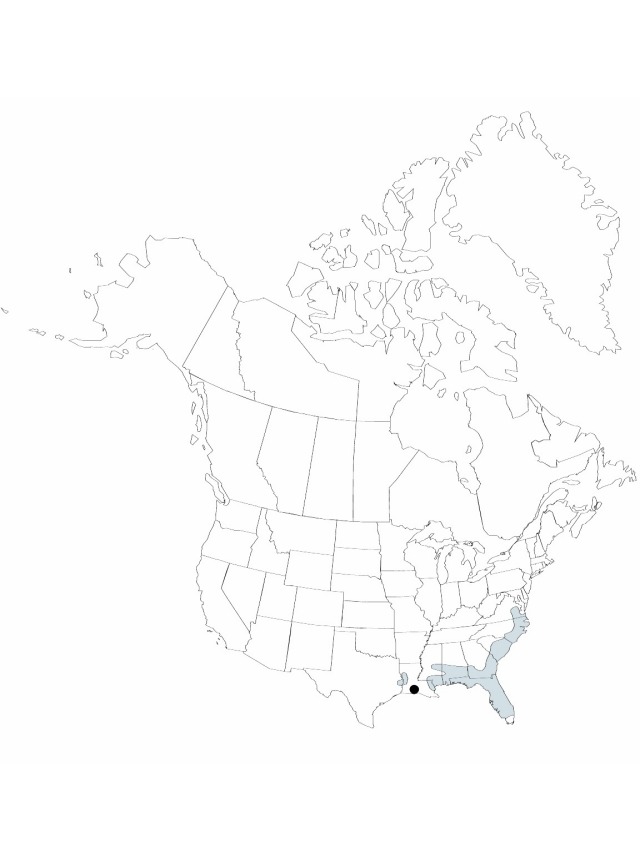Difference between revisions of "Xyris platylepis"
Fl. South. U.S. 501. 1860.
FNA>Volume Importer |
FNA>Volume Importer |
||
| Line 23: | Line 23: | ||
|elevation=0–300 m | |elevation=0–300 m | ||
|distribution=Ala.;Fla.;Ga.;La.;Miss.;N.C.;S.C.;Tex.;Va. | |distribution=Ala.;Fla.;Ga.;La.;Miss.;N.C.;S.C.;Tex.;Va. | ||
| − | |discussion=<p>Xyris platylepis, which may be associated with other bulbous-based species such as X. torta and X. caroliniana, appears very similar to larger extremes of the former but differs in its plane (rather than prominently ribbed) leaf surfaces and its lacerate (rather than ciliate) sepal keels, and from the latter in its more shallowly set and pinkish or red (rather than chestnut brown) bases, as well as in its sepal keels that are lacerate rather than fimbriate.</p> | + | |discussion=<p><i>Xyris platylepis</i>, which may be associated with other bulbous-based species such as <i>X. torta</i> and <i>X. caroliniana</i>, appears very similar to larger extremes of the former but differs in its plane (rather than prominently ribbed) leaf surfaces and its lacerate (rather than ciliate) sepal keels, and from the latter in its more shallowly set and pinkish or red (rather than chestnut brown) bases, as well as in its sepal keels that are lacerate rather than fimbriate.</p> |
|tables= | |tables= | ||
|references= | |references= | ||
| Line 47: | Line 47: | ||
|publication year=1860 | |publication year=1860 | ||
|special status= | |special status= | ||
| − | |source xml=https://jpend@bitbucket.org/aafc-mbb/fna-data-curation.git/src/ | + | |source xml=https://jpend@bitbucket.org/aafc-mbb/fna-data-curation.git/src/8f726806613d60c220dc4493de13607dd3150896/coarse_grained_fna_xml/V22/V22_429.xml |
|genus=Xyris | |genus=Xyris | ||
|species=Xyris platylepis | |species=Xyris platylepis | ||
Revision as of 15:58, 18 September 2019
Herbs, perennial, cespitose, occasionally solitary, 2–8(–10) cm, base bulbous. Stems compact. Leaves erect or ascending, 15–30(–50) cm; sheaths pinkish to red, soft; blade green, linear, flattened, twisted, 5–10 mm wide, smooth, margins smooth. Inflorescences: scape sheaths exceeded by leaves; scapes linear, often flexuous, terete, to (1.5–)2(–3) mm wide, distally 2–4(–6) ribbed, ribs smooth or papillate; spikes ovoid to cylindric, 8–30 mm; fertile bracts 5–7 mm, margins entire, apex rounded. Flowers: lateral sepals included, light brown, slightly curved, 5–7 mm, keel scarious, lacerate; petals, unfolding at midday, blade broadly obovate, 5 mm; staminodes bearded. Seeds translucent, ellipsoid, 0.5–0.6 mm, longitudinally irregularly ribbed, with fainter cross lines. 2n = 18.
Phenology: Flowering summer–fall (all year south).
Habitat: Moist to wet acid, sandy seeps, bogs, low pine flatwoods, savannas, and ditch banks
Elevation: 0–300 m
Distribution

Ala., Fla., Ga., La., Miss., N.C., S.C., Tex., Va.
Discussion
Xyris platylepis, which may be associated with other bulbous-based species such as X. torta and X. caroliniana, appears very similar to larger extremes of the former but differs in its plane (rather than prominently ribbed) leaf surfaces and its lacerate (rather than ciliate) sepal keels, and from the latter in its more shallowly set and pinkish or red (rather than chestnut brown) bases, as well as in its sepal keels that are lacerate rather than fimbriate.
Selected References
None.